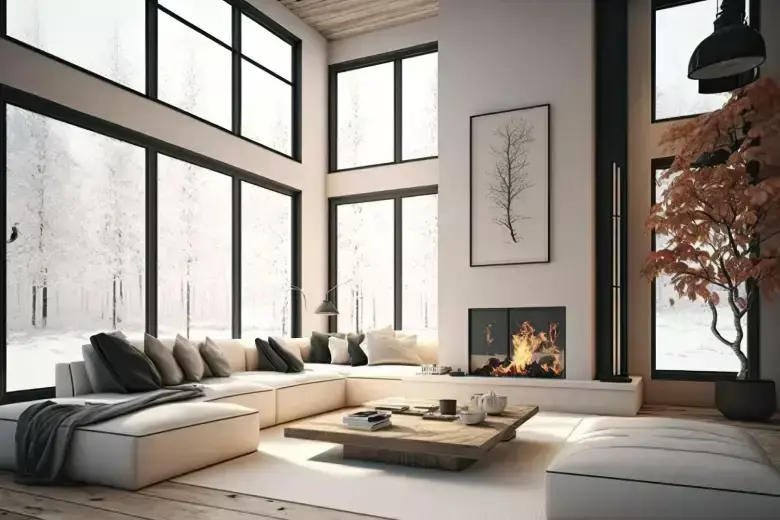Are you curious about where a career in interior design might take you? If so, then look no further!
In this ultimate guide to interior design, we’ll be running through everything you need to know about this creative and exciting field, rounding off with the concrete steps to take if you’re interested in launching an interior design career.
Here’s a clickable list of everything we’ll be covering in this article!
- What is interior design?
- What’s the main purpose of interior design?
- Why is interior design important?
- What are the major interior design styles?
- What are the key principles of interior design?
- Key interior design software
- What does an interior designer do?
- Interior design jobs, salaries, and careers
- What’s the difference between interior design and interior decorating?
- How to become an interior designer
- Conclusion
Ready to learn? Then let’s get started!
What is interior design?
Interior design refers to the enhancement of the interior of a building or room in order to create a more aesthetically pleasing, functional, accessible, and safe space for those who use or inhabit it. While many of us might think of interior design as simply choosing furniture or arranging the lighting, the profession includes many practical and interpersonal elements such as construction organization, extensive research, and relationship building.
A brief history of interior design
Interior design can be traced as far back as ancient civilizations, where decoration and simple furnishings were used to create more comfortable living areas. Evidence suggests the Egyptians, Greeks, and Romans all embraced a certain amount of interior decoration, using richly colored fabrics and elaborate mosaics to decorate their homes and recreational spaces. Interior design evolved further during the Renaissance period when internal decoration became a signifier of wealth, decadence, and luxury. This desire to use furnishings and interior design to showcase status frequently involved the adoption of more expensive materials for those who could afford it.
By the 19th and 20th centuries, interior design had, along with the rise of industrialization, evolved to focus more on functionality and the modern ideas of minimalism and simplicity. Today, trends in interior design tend to focus on sustainability in response to the climate change crisis, and creating interiors which can promote positive well-being as increasing numbers of people choose to work from home.
What’s the main purpose of interior design?
While we might think of interior design as being purely an aesthetic endeavor, its main purpose is actually more nuanced. Although the visual aesthetic of a space is a very important element of an interior designer’s work, it has to work in harmony with the accessibility and functionality of a space. Ultimately, an interior designer must ensure that everyone who uses the space can do so in a safe way, while enabling them to meet all of their immediate needs.
Why is interior design important?
While it’s easy to say that interior design makes a space more visually appealing, the practice actually brings about a range of other benefits that should not be underestimated. Below are some of the main reasons why interior design is so highly valued.
Maximizes the amount of available space
Interior design enables us to make the most of the space we have. In smaller spaces, an interior designer will opt for furniture that uses up minimal floor space, such as floating shelves, tables and chairs with narrow legs, and couches that are shallow-depth. Vertical spaces will also be taken advantage of with hanging plants and built-in bookshelves. Stowable and multipurpose furniture also helps create more space, while mirrors and skylights can increase the amount of natural light coming into a room, making a room appear larger and feel more spacious.
Enhances well-being
Improving the quality of life and well-being of those occupying a space is a hugely important function of interior design. By combining specific fabrics, materials, colors, and natural and artificial lights, an interior designer can enhance the atmosphere in a room and boost the moods of its inhabitants, turning a house into a home, or an office into an exciting, energetic, and productive workspace. An interior designer will seek to inject personality and personal preferences into a space, making it a true reflection of those who live or work there.
Increases property value
Working on the design of an interior can bring about an increase in the value of your property. This is not only true when major renovations, such as an extension, have taken place; minor interior design and decoration changes such as freshly painted walls, or even rearranging or modernizing the furniture in a room, can increase the interest prospective buyers show.
Can aid a sustainable lifestyle
The interior design of buildings and homes is increasingly reflecting a need for sustainable living as it mirrors sustainable consumer trends and behavior in the face of a changing climate. An interior designer can design for energy efficiency, bringing in elements such as carpets and drapes for room insulation and heat retention, and using paint colors and reflective surfaces which reflect light to save on artificial lighting. An interior designer will also have knowledge of which materials, such as organic and renewable materials, create the lowest environmental impact, and which labels, standards, and certifications on those materials ensure they come from legitimate sources. Waste reduction is also a consideration in interior design, with interior designers opting to upcycle or reuse products rather than simply discard items that are no longer deemed “in fashion.” The longevity and flexibility of products also play a role in interior design today, as consumers seek to use items for as long as possible in order to impact the planet less. When combined, these changes to interior spaces contribute to and support an individual’s sustainable lifestyle or a business’ climate impact.
 Caption: Traditional interior design
Caption: Traditional interior design

















